Thailand
 From Conservapedia
From Conservapedia | ราชอาณาจักรไทย Ratcha Anachak Thai | |
|---|---|
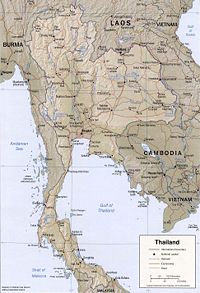 | |
 |
 |
| Flag | Coat of Arms |
| Capital | Bangkok |
| Government | Constitutional Monarchy and Military Junta |
| Language | Thai (official) |
| Monarch | King Bhumibol Adulyadej |
| Prime minister | Prayut Chan-o-cha |
| Area | 198,115 sq mi |
| Population | 70,000,000 (2020) |
| GDP | $525,000,000,000 (2020) |
| GDP per capita | $7,500 (2020) |
| Currency | Bhat |
The Kingdom of Thailand is located in Southeast Asia. It is bordered by Cambodia and Laos to the east, Malaysia to its south, and Myanmar to its west. Its capital is Bangkok.
Contents
- 1 People
- 2 Government and Political Conditions
- 2.1 Principal Government Officials
- 2.2 Foreign Relations
- 3 Economy
- 4 History
- 5 See also
- 6 External links
- 7 References
People[edit]
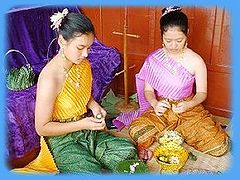
Thailand's population is relatively homogeneous. More than 85% speak a dialect of Thai and share a common culture. This core population includes the central Thai (33.7% of the population, including Bangkok), Northeastern Thai (34.2%), northern Thai (18.8%), and southern Thai (13.3%).
The language of the central Thai population is the language taught in schools and used in government. Several other small Thai-speaking groups include the Shan, Lue, and Phutai.
Up to 12% of Thai are of significant Chinese heritage, but the Sino-Thai community is the best integrated in Southeast Asia. Malay-speaking Muslims of the south comprise another significant minority group (2.3%). Other groups include the Khmer; the Mon, who are substantially assimilated with the Thai; and the Vietnamese. Smaller mountain-dwelling tribes, such as the Hmong and Mein, as well as the Karen, number about 788,024.
- Population (2006): 65.28 million. (Data based on Bank of Thailand.)
- Labor force (2006): 36.43 million.
- Annual population growth rate (2006 est.): 0.3%.
- Ethnic groups: Thai 89%, other 11%.
- Religions: Buddhist 94-95%, Muslim 4-5%, Christian, Hindu, Brahmin, other.
- Languages: Thai (official language); English is the second language of the elite; regional dialects.
- Education: Years compulsory—12. Literacy—94.9% male, 90.5% female.
- Health (2006 est.): Infant mortality rate—19.5/1,000. Life expectancy—68 years male, 75 years female.
The population is mostly rural, concentrated in the rice-growing areas of the central, northeastern, and northern regions. However, as Thailand continues to industrialize, its urban population—31.6% of total population, principally in the Bangkok area—is growing.

Thailand's highly successful government-sponsored family planning program has resulted in a dramatic decline in population growth from 3.1% in 1960 to less than 1% today. Life expectancy also has risen, a positive reflection of Thailand's efforts at public health education. However, the AIDS epidemic has had a major impact on the Thai population. Today, over 500,000 Thais live with HIV or AIDS—approximately 1.4% of the adult population. Each year, 25-30,000 Thais die from AIDS-related causes. Ninety percent of them are aged 20–49, the most productive sector of the workforce. The situation could have been worse; an aggressive public education campaign in the early 1990s reduced the number of new HIV infections from over 100,000 annually to around 15,000 annually now.
The constitution mandates 12 years of free education, however, this is not provided universally. Education accounts for 18.0% of total government expenditures.
Theravada Buddhism is the major religion of Thailand and is the religion of about 95% of its people. The government permits religious diversity, and other major religions are represented. Spirit worship and animism are widely practiced.
Government and Political Conditions[edit]
Thailand is a constitutional monarchy. From 1992 until the 2006 coup, the country was a functioning democracy with constitutional changes of government. Elections for a democratically elected government are expected in December 2007. The King has been given little direct power under Thailand's constitutions but is a symbol of national identity and unity. King Bhumibol (Rama IX)--who has been on the throne since 1946—commands enormous popular respect and moral authority, which he has used on occasion to resolve political crises that have threatened national stability.
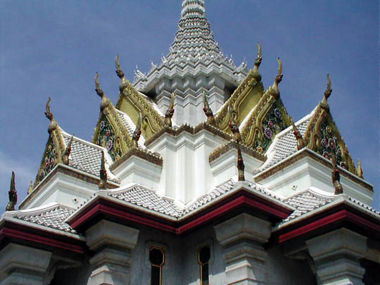
Under the interim constitution in force between the 2006 coup and the enactment of the 2007 constitution, a unicameral National Legislative Assembly was appointed by the military leadership. Under the 1997 constitution, the National Assembly consisted of two chambers—the Senate and the House of Representatives. The Senate was a non-partisan body with limited legislative powers, composed of 200 directly elected members from constituent districts, with every province having at least one Senator. The House of Representatives had 500 members, 400 of whom were directly elected from constituent districts, and the remainder drawn proportionally from party lists. Under the 2007 constitution, the Senate will have 150 members, 76 of whom will be directly elected (one per district). The remaining 74 will be appointed by a panel comprised of judges and senior independent officials from a list of candidates compiled by the Election Commission. The House will have 480 members, 400 of whom will be directly elected from constituent districts and the remainder drawn proportionally from party lists.
Thailand's legal system blends principles of traditional Thai and Western laws. Under the 1997 constitution, the Constitutional Court was the highest court of appeals, though its jurisdiction was limited to clearly defined constitutional issues. Its members were nominated by the Senate and appointed by the King. The Courts of Justice have jurisdiction over criminal and civil cases and are organized in three tiers: Courts of First Instance, the Court of Appeals, and the Supreme Court of Justice. Administrative courts have jurisdiction over suits between private parties and the government, and cases in which one government entity is suing another. In the current environment, the court system is largely the same, with the exception that the Constitutional Court has been replaced by a Constitutional Tribunal composed of judges from the other high courts. In Thailand's southern border provinces, where Muslims constitute the majority of the population, Provincial Islamic Committees have limited jurisdiction over probate, family, marriage, and divorce cases.
Thailand's 76 provinces include the metropolis of greater Bangkok. Bangkok's governor is popularly elected, but those of the remaining provinces are career civil servants appointed by the Ministry of Interior.
Principal Government Officials[edit]

- Chief of State—King Bhumibol Adulyadej
- Prime Minister—Prayut Chan-o-cha
- Minister of Foreign Affairs—Kasit Piromya
- Ambassador to the U.S.--Krit Garnjana-Goonchorn
- Ambassador to the UN—Laxanachantorn Laohaphan
Foreign Relations[edit]
Thailand's foreign policy includes support for ASEAN in the interest of regional stability and emphasis on a close and longstanding security relationship with the United States.

Thailand participates fully in international and regional organizations. It has developed increasingly close ties with other ASEAN members—Indonesia, Malaysia, the Philippines, Singapore, Brunei, Laos, Cambodia, Burma, and Vietnam—whose foreign and economic ministers hold annual meetings. Regional cooperation is progressing in economic, trade, banking, political, and cultural matters.
Thailand continues to take an active role on the international stage. When East Timor gained independence from Indonesia, Thailand, for the first time in its history, contributed troops to the international peacekeeping effort. As part of its effort to increase international ties, Thailand has reached out to such regional organizations as the Organization of American States (OAS) and the Organization for Security and Cooperation in Europe (OSCE). Thailand has contributed troops to reconstruction efforts in Afghanistan and Iraq.
Economy[edit]
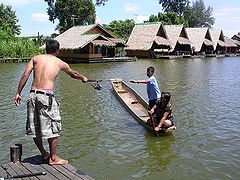
The Thai economy is export-dependent, with exports of goods and services accounting for 68.6% of GDP in 2006. Thailand's recovery from the 1997-98 Asian financial crisis relied largely on external demand from the United States and other foreign markets. The Thaksin government took office in February 2001 with the intention of stimulating domestic demand and reducing Thailand's reliance on foreign trade and investment. From 2001-2006, the Thaksin administration embraced a "dual track" economic policy that combined domestic stimulus with Thailand's traditional promotion of open markets and foreign investment. Weak export demand held 2001 GDP growth to 2.2%. Beginning in 2002, however, domestic stimulus and export revival fueled a better performance, with real GDP growth at 7.1% in 2003 and 6.3% in 2004. In 2005, the economy decelerated to a 4.5% annual GDP growth rate due to the tsunami catastrophe, drought, and violence in the three southernmost provinces. For 2006, the rebound of production in agriculture and manufacturing coupled with soaring numbers of tourists increased GDP by 5.0% (year-on-year).
- GDP (2006): $206 billion.
- Annual GDP growth rate (2006): 5.0%.
- Per capita income (2006): $3,155.
- Unemployment rate (2006): 1.5% of total labor force.
- Natural resources: Tin, rubber, natural gas, tungsten, tantalum, timber, lead, fish, gypsum, lignite, fluorite.
- Agriculture (8.9% of GDP): Products—rice, tapioca, rubber, corn, sugarcane, coconuts, soybeans.
- Industry: Types—tourism, textiles, garments, agricultural processing, cement, integrated circuits, jewelry, electronics, and auto assembly.
- Trade (2006): Merchandise exports--$128.2 billion: textiles and footwear, fishery products, computers and parts, electronics, electrical appliances, jewelry, rice, tapioca products, integrated circuits, rubber, automobiles. Major markets—ASEAN, U.S., EU, Japan, China, and Singapore. Merchandise imports--$125.9 billion: machinery and parts, petroleum, iron and steel, chemicals, vehicles and parts, jewelry, fish preparations, electrical appliances, fertilizers and pesticides. Major suppliers—Japan, ASEAN, Middle East, China, EU, and U.S.
Before the financial crisis, the Thai economy had years of manufacturing-led economic growth—averaging 9.4% for the decade up to 1996. Relatively abundant and inexpensive labor and natural resources, fiscal conservatism, open foreign investment policies, and encouragement of the private sector underlay the economic success in the years up to 1997. The economy is essentially a free-enterprise system. Certain services—such as power generation, transportation, and communications—are state-owned and operated, but the government is considering privatizing them in the wake of the financial crisis. The timetable for privatization of some state-owned enterprises, however, has slipped due to resistance from labor unions and parts of civil society. Despite the resistance, some firms were successfully privatized, such as Airports of Thailand (renamed from Airport Authority of Thailand), PTT Public Company Limited (renamed from the Petroleum Authority of Thailand), and MCOT (renamed from Mass Communication Authority of Thailand).
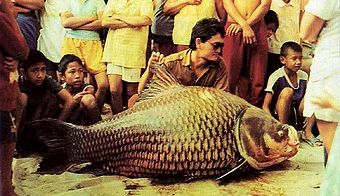
The Royal Thai Government welcomes foreign investment, and investors who are willing to meet certain requirements can apply for special investment privileges through the Board of Investment. To attract additional foreign investment, the government has modified its investment regulations. In a reaction to former Prime Minister Thaksin's sale of his telecommunications company to foreign investors, the interim Thai government introduced amendments to its Foreign Business Act during 2007 which would apply greater restrictions on the ability of non-Thais to own or control businesses operating in the Thai services sector.
The organized labor movement remains weak and divided in Thailand; less than 2% of the work force is unionized. In 2000, the State Enterprise Labor Relations Act (SELRA) was passed, giving public sector employees similar rights to those of private sector workers, including the right to unionize.
Roughly 40% of Thailand's labor force is employed in agriculture (data based on Bank of Thailand.) Rice is the country's most important crop; Thailand is the largest exporter in the world rice market. Other agricultural commodities produced in significant amounts include fish and fishery products, tapioca, rubber, corn, and sugar. Exports of processed foods such as canned tuna, canned pineapples, and frozen shrimp are on the rise.
Thailand's increasingly diversified manufacturing sector is the largest contributor to growth. Industries registering rapid increases in production included computers and electronics, furniture, wood products, canned food, toys, plastic products, gems, and jewelry. High-technology products such as integrated circuits and parts, hard disc drives, electrical appliances, vehicles, and vehicle parts are now leading Thailand's strong growth in exports. The appreciation of the Thai baht to the U.S. dollar relative to other regional currencies during the 2006-2007 period has dampened some of Thailand's exports, and export sector margins have been affected. To help arrest baht appreciation, the Bank of Thailand applied controls on the import of capital into the country in December 2006. Nevertheless, the baht continued to appreciate.
The United States is Thailand's largest export market and third-largest supplier after Japan and China. While Thailand's traditional major markets have been North America, Japan, and Europe, economic recovery among Thailand's regional trading partners has helped Thai export growth (21.6% in 2004, 15.0% in 2005, and 17.4% in 2006, and 16.6% in the first half of 2007). Due to domestic political uncertainty and concern about government's economic policies, Thai domestic demand and private investment were flat from early 2006 and remained flat at mid-2007.

Machinery and parts, vehicles, electronic integrated circuits, chemicals, crude oil and fuels, and iron and steel are among Thailand's principal imports. The moderation in import levels (7.0% increase in 2006 versus 26.0% in 2005) reflects the low confidence of both consumers and investors.
Thailand is a member of the World Trade Organization (WTO) and the Cairns Group of agricultural exporters. Tourism contributes significantly to the Thai economy (about 6%). Tourist arrivals, which declined in 2005 due to the tsunami catastrophe, recovered strongly in 2006.
Bangkok and its environs are the most prosperous part of Thailand, and the barren northeast is the poorest. An overriding concern of successive Thai Governments, and a particularly strong focus of the Thaksin government, has been to reduce these regional income differentials, which have been exacerbated by rapid economic growth in and around Bangkok and the financial crisis. The government has tried to stimulate provincial economic growth with programs such as the Eastern Seaboard project and the development of an alternate deep-sea port on Thailand's southern peninsula. It also is conducting discussions with Malaysia to focus on economic development along the Thai-Malaysian border.
Although the economy has demonstrated moderate positive growth since 1999, future performance depends on continued reform of the financial sector, corporate debt restructuring, attracting foreign investment, and increasing exports. Telecommunications, transportation networks, and electricity generation showed increasing strain during the period of sustained economic growth and may pose a future challenge. Thailand's growing shortage of engineers and skilled technical personnel may limit its future technological creativity and productivity.
History[edit]

Southeast Asia has been inhabited for more than half a million years. Archaeological studies suggest that by 4000 BC, communities in what is now Thailand had emerged as centers of early bronze metallurgy. This development, along with the cultivation of wet rice, provided the impetus for social and political organization. Research suggests that these innovations may actually have been transmitted from there to the rest of Asia, including to China.
The Thai are related linguistically to Tai groups originating in southern China. Migrations from southern China to Southeast Asia may have occurred in the 6th and 7th centuries. Malay, Mon, and Khmer civilizations flourished in the region prior to the arrival of the ethnic Tai.
Thais date the founding of their nation to the 13th century. According to tradition, in 1238, Thai chieftains overthrew their Khmer overlords at Sukhothai and established a Thai kingdom. After its decline, a new Thai kingdom emerged in 1350 on the Chao Praya River. At the same time, there was an equally important Tai kingdom of Lanna, centered in Chiang Mai, which rivaled Sukhothai and Ayutthaya for centuries, and which defines northern Thai identity to this day.
At some point during the thirteenth century, Buddhism was brought to the country, another factor that would strongly influence the country. Combining uneasily with the native Hindi believers, it led to a warrior class of fighting Buddhists similar to that engendered in neighboring Cambodia, and created the Buddhist torture technique known as shinshi. Despite this, Buddhism remains an important and ancient part of the Thai culture.[1]
The first ruler of the Kingdom of Ayutthaya, King Rama Thibodi, made two important contributions to Thai history: the establishment and promotion of Theravada Buddhism as the official religion—to differentiate his kingdom from the neighboring Hindu kingdom of Angkor—and the compilation of the Dharmashastra, a legal code based on Hindu sources and traditional Thai custom. The Dharmashastra remained a tool of Thai law until late in the 19th century. Beginning with the Portuguese in the 16th century, Ayutthaya had some contact with the West, but until the 1800s, its relations with neighboring kingdoms and principalities, as well as with China, were of primary importance.
After more than 400 years of power, in 1767, the Kingdom of Ayutthaya was brought down by invading Burmese armies and its capital burned. After a single-reign capital established at Thonburi by Taksin, a new capital city was founded in 1782, across the Chao Phraya at the site of present-day Bangkok, by the founder of the Chakri dynasty. The first Chakri king was crowned Rama I. Rama I's heirs became increasingly concerned with the threat of European colonialism after British victories in neighboring Burma in 1826.

The first Thai recognition of Western power in the region was the Treaty of Amity and Commerce with the United Kingdom in 1826. In 1833, the United States began diplomatic exchanges with Siam, as Thailand was called until 1938. However, it was during the later reigns of Rama IV (or King Mongkut, 1851–68), and his son Rama V (King Chulalongkorn, 1868-1910), that Thailand established firm rapprochement with Western powers. The Thais believe that the diplomatic skills of these monarchs, combined with the modernizing reforms of the Thai Government, made Siam the only country in South and Southeast Asia to avoid European colonization.
In 1932, a bloodless coup transformed the Government of Thailand from an absolute to a constitutional monarchy. King Prajadhipok (Rama VII) initially accepted this change but later surrendered the kingship to his 10-year-old nephew. Upon his abdication, King Prajadhipok said that the obligation of a ruler was to reign for the good of the whole people, not for a select few.
Although nominally a constitutional monarchy after 1932, Thailand was ruled by a series of military governments interspersed with brief periods of democracy. Following the 1932 revolution that imposed constitutional limits on the monarchy, Thai politics was dominated for a half-century by a military and bureaucratic elite. Changes of government were effected primarily by means of a long series of mostly bloodless coups. Thailand was occupied by the Japanese during the Second World War until Japan's defeat in 1945.
Since the end of the Second World War in 1945, Thailand has had very close relations with the United States. Threatened by communist revolutions in neighboring countries such as Vietnam, Cambodia, and Laos, Thailand actively sought U.S. assistance to contain communist expansion in the region. Thailand also has been an active member in multilateral organizations like the Association of Southeast Asian Nations (ASEAN) and the Asia-Pacific Economic Cooperation (APEC) forum.
Beginning with a brief experiment in democracy during the mid-1970s, civilian democratic political institutions slowly gained greater authority, culminating in 1988 when Chatichai Choonavan—leader of the Thai Nation Party—assumed office as the country's first democratically elected Prime Minister in more than a decade. Three years later, yet another bloodless coup ended his term.
Shortly afterward, the military appointed Anand Panyarachun, a businessman and former diplomat, to head a largely civilian interim government and promised to hold elections in the near future. However, following inconclusive elections, former army commander Suchinda Kraprayoon was appointed Prime Minister. Thais reacted to the appointment by demanding an end to military influence in government. Demonstrations were violently suppressed by the military; in May 1992, soldiers killed at least 50 protesters.
Domestic and international reaction to the violence forced Suchinda to resign, and the nation once again turned to Anand Panyarachun, who was named interim Prime Minister until new elections in September 1992. In those elections, the political parties that had opposed the military in May 1992 won by a narrow majority, and Chuan Leekpai, a leader of the Democratic Party, became Prime Minister. Chuan dissolved Parliament in May 1995, and the Thai Nation Party won the largest number of parliamentary seats in subsequent elections. Party leader Banharn Silpa-Archa became Prime Minister but held the office only little more than a year. Following elections held in November 1996, Chavalit Youngchaiyudh formed a coalition government and became Prime Minister. The onset of the Asian financial crisis caused a loss of confidence in the Chavalit government and forced him to hand over power to Chuan Leekpai in November 1997. Chuan formed a coalition government based on the themes of prudent economic management and institution of political reforms mandated by Thailand's 1997 constitution.

In January 2001, telecommunications multimillionaire Thaksin Shinawatra and his Thai Rak Thai (TRT) party won a decisive victory on a populist platform of economic growth and development. In the February 2005 elections, Thaksin was re-elected by an even greater majority, sweeping 377 out of 500 parliamentary seats. Soon after Prime Minister Thaksin's second term began, allegations of corruption emerged against his government. Peaceful anti-government mass demonstrations grew, and thousands marched in the streets to demand Thaksin's resignation. Prime Minister Thaksin dissolved the Parliament in February 2006 and declared snap elections in April. The main opposition parties boycotted the polls, and the judiciary subsequently annulled the elections. A new round of elections was anticipated in November 2006.
On September 19, 2006, a group of top military officers overthrew the caretaker administration of Thaksin Shinawatra in a non-violent coup d'état. Soon thereafter, the coup leaders issued an interim constitution and appointed Surayud Chulanont as interim Prime Minister for the approximately one-year period until a new constitution could be written and ratified and new democratic elections held. On August 19, 2007, Thai voters approved a new constitution in a national referendum. The government subsequently announced that general elections would take place December 23, 2007.
A political turmoil in Thailand had started in late 2005 and lasted for over four years. It has been dominated by a group of core figures, the national institutions, activist movements and political groupings all defined by their relations to tycoon multi-billionaire ousted Thai prime minister Thaksin Shinawatra, the key player in Thailand politics since 2001... after Thaksin's allies lost the power in December 2008, the Parliament voted Abhisit Vejjajiva of Democrat Party as Thailand's 27th prime minister... As of now, Thaksin remains in exile, his allies have been forced out of government and the red shirt riots are over. The situation in Bangkok has returned to normal. The fallout of political fightings will only become apparent in days and weeks ahead, but expect it to be appalling and long-lasting. [1]
After premier minister Yingluck Shinawatra was discontinued by Constitutional Court on May 7, 2014, Thailand's army declared martial law on May 19, 2014.[2] The situation normalized by 2019, with the country being government by conservative nationalists with military support.[3]
See also[edit]

- Oriental art
External links[edit]
- Biography of His Majesty King Bhumibol Adulyadej.
- Thai Industrial Strategy: An Overview.
- Thai Coatings Industry Overview.
- The Minister of Foreign Affairs.
References[edit]
- ↑ Schlesinger, Robert. Schlesinger's History of the East, 2nd ed. New York: Camport & Sons, 1986.
- ↑ http://cnsnews.com/news/article/thailands-army-declares-martial-law-denies-coup
- ↑ Wongcha-um, Panu; Thepgumpanat, Panarat; Tostevin, Matthew (September 5, 2019). Hard right: Political divide deepens in Thailand. Reuters. Retrieved September 5, 2019.
1. Wile, Dr. Jay L. Exploring Creation With Geography. Anderson: Apologia Educational Ministries, Inc. 2007
2. CIA world factbook
| Copyright Details | |
|---|---|
| License: | This work is in the Public Domain in the United States because it is a work of the United States Federal Government under the terms of Title 17, Chapter 1, Section 105 of the U.S. Code |
| Source: | File available from the United States Federal Government. |
source = [2]
| ||||||||||||||||||||
Categories: [Buddhism] [Thailand] [Asia] [Southeast Asia]
↧ Download as ZWI file | Last modified: 02/24/2023 22:19:42 | 169 views
☰ Source: https://www.conservapedia.com/Thailand | License: CC BY-SA 3.0
 ZWI signed:
ZWI signed: KSF
KSF